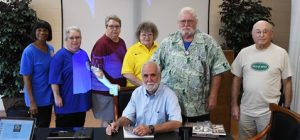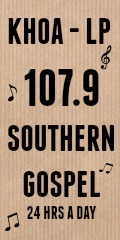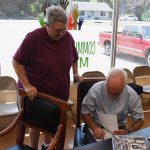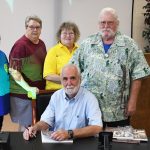Rotarians learn about country doctors in Arkansas

PRESCOTT – Dr. Sam Taggart was the featured speaker at the Prescott Rotary Club Tuesday afternoon.
The members were regaled with Taggart’s talking about his second book, “Country Doctors of Arkansas”, a history of small town doctors in the state. Taggart said he’s been writing since he was 17 and wrote a couple of novels. Former director of the Arkansas Department of Health, Joe Bates, asked Taggart about writing a book on public health in Arkansas in 2006. He did, with the book being published by the Arkansas Times. Bates, in talking with Taggart, said a lot of country doctors labor way in relative obscurity, unknown except to those they treat and their community.
This was the germ for the second book, with Taggart interviewing doctors in towns with populations of 2,500 to 5,000. He made sure to point out that Dr. Mike Young is included in the book. Doing the research and interviews, which were recorded on video, he said, was great fun, adding the interviews and videos are archived in the Arkansas Academy of Family Physicians and the National Academy of Family Physicians for those who want to check them out.
The first possible county doctor in Arkansas was discovered in Northeast Arkansas near the Sloan site, where an organized cemetery, dating back 10,500 years, as found. Areas, he said, with organized cemeteries also tended to have priest healers, who were women and the first doctors. The women stayed home, tended to babies and the sick. Taggart said this is likely the oldest documented cemetery in the western hemisphere.
In 1804, he said, there were maybe 3-4,000 people in Arkansas. Those who came first looked for potable water where there weren’t many mosquitos. Communities or villages developed around these sites and sooner or later, someone would come and set up shop as a doctor. However, before that, he continued, a practice known as “granny doctoring” was done where grandmothers used remedies passed down to them to doctor those in need. In turn, they passed this knowledge to their daughters and granddaughters. There are three versions of granny doctor, he told the Rotarians, first are the “yarb” or herb doctors who took care of their families. Next came the midwifes, who passed their skills down to their daughters and granddaughters, and finally, the seer, or “hoodoo” doctors.
Most early doctors, he said, had little or no real training, but learned at the hands of another doctor. These were normally boys 16-18-years-old who’d learned all they could in school and, if they were smart enough, encouraged to go into medicine.
Taggart said there are three characteristics to country doctors, and this hasn’t changed since the first 10,500 years ago. The traits are, a quiet voice, a warm smile and a soft touch. He told the members there’s rarely a desk between a country doctor and their patient, and there’s always a box of facial tissue nearby for when the patient gets upset. “These are part of the tools of the trade,” he said.
Country doctors almost always choose to return to small towns, no matter where they started their practice. For his next book, Taggart is researching the history of family lineages of doctors in the state from 1800 to now. This, he said, is because most families with doctors tend to have children who also go into medicine.
Originally, all doctors were “horse and buggy” doctors, taking their medical bags with them where they went. Today, he said, there’s telemedicine and the debate on its effectiveness. Taggart said studies have shown it’s good when the doctor is dealing with an established patient, otherwise, it can be nothing more than a vending machine for medications. “Technology has changed things drastically.”
The oldest practicing doctor he’s interviewed for his next book was 98 years old, while the youngest was 34. He said there are questions as to whether there will be country doctors in the future. The answer, he continued, is yes, though they may have different initials behind their name.
Taggart plans a companion book to this one, and asked for club members to relate their doctor stories to him. He provided cards with his phone number and email address. He said he finished his third book, “For Every Family a Family Doctor” which will be released in January and he and his wife are working on one called “Against the Odds; Arkansas Women in Medicine before 1972”.






